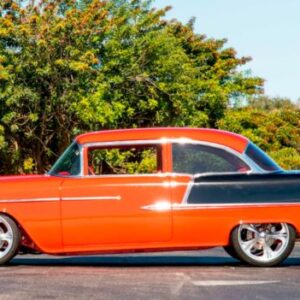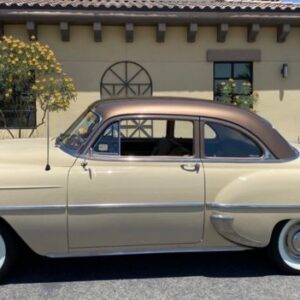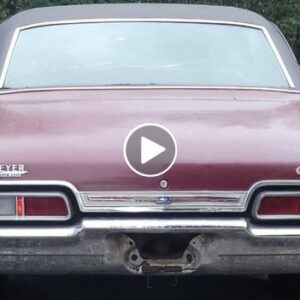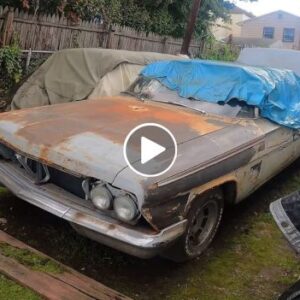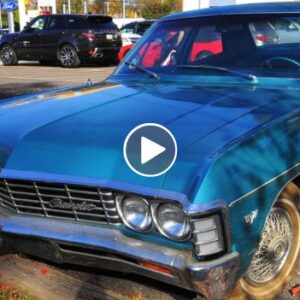The 1982 Cadillac Seville is an iconic luxury sedan that represents the pinnacle of American automotive design and engineering during the early 1980s. With its distinctive styling, advanced features, and exceptional comfort, the Seville has earned its place as a sought-after classic among car enthusiasts and collectors alike.
In this comprehensive guide, we will explore the history, design, features, and performance of the 1982 Cadillac Seville, revealing why this elegant vehicle continues to captivate the hearts of luxury car aficionados.
1. A Brief History of the Cadillac Seville
The Cadillac Seville was first introduced in 1975 as a response to the growing demand for smaller, more fuel-efficient luxury vehicles, driven by the oil crisis of the 1970s. As an upscale alternative to the traditional full-size Cadillac models, the Seville aimed to compete with European luxury sedans, such as the Mercedes-Benz S-Class and BMW 7 Series.
The first-generation Seville (1975-1979) was based on the GM X-platform and borrowed some of its underpinnings from the Chevrolet Nova. However, the Seville was distinguished by its unique styling, high-quality materials, and advanced features, which set it apart from other GM products.
-1686725089.jpg)
In 1980, Cadillac introduced the second-generation Seville, featuring an all-new design and a host of technological innovations. The 1982 model year marked the third year of production for the second-generation Seville, and it continued to build upon the success of its predecessors by offering an unparalleled combination of luxury, performance, and sophistication.
2. Sales and Production
Cadillac produced 44,922 Sevilles for the 1982 model year. This was down from 53,487 in 1981 due to an economic recession in the early 1980s. The Seville continued to be Cadillac’s best-selling sedan in 1982, representing nearly 1/3 of Cadillac’s total vehicle sales that year.
-1686725111.jpg)
The Seville saw a sales resurgence later in the 1980s as the economy recovered and new generations were introduced. The 1982 Seville represented an important model for Cadillac as it transitioned to more fuel-efficient and electronics-focused vehicles in the 1980s while still retaining its luxury image. The Seville was a pioneer for Cadillac in these areas.
3. Market Reception
The market reception of the 1982 Cadillac Seville was generally positive, although it did face some criticisms as well. Here are some factors that influenced the perception of the 1982 Cadillac Seville:
Styling
The 1982 Seville featured a sleek and modern design, which was well-received by many customers. It had a more aerodynamic look compared to its predecessor, and its overall appearance was considered elegant and refined.
-1686725124.jpg)
Size and Comfort
The Seville was positioned as a more compact luxury car, offering a balance between luxury and practicality. It provided a comfortable ride with spacious seating for both the driver and passengers.
Fuel Efficiency
The 1982 Seville was designed to be more fuel-efficient compared to the larger Cadillac models. This aspect was appreciated by customers who were looking for a luxury car with better fuel economy during a period of rising gasoline prices.
-1686725347x1024.jpg)
Technology and Features
The 1982 Seville incorporated various technological features and amenities that were considered advanced for its time. These included power accessories, a digital instrument cluster, and a variety of luxury options.
However, the 1982 Cadillac Seville also faced some criticism, primarily related to build quality and reliability issues. Some owners reported problems with mechanical components, electrical systems, and general reliability, which affected the overall perception of the vehicle.
Despite these challenges, the 1982 Cadillac Seville maintained a decent market reception overall, appealing to customers who desired a luxury car with a more compact size and improved fuel efficiency. The specific market response and customer satisfaction may vary, and it’s advisable to refer to contemporary reviews, owner experiences, and automotive publications from that time for a more comprehensive understanding of the market reception.
4. Design
The 1982 Cadillac Seville featured a design that was considered modern and sophisticated for its time. Here are some key design elements and features of the 1982 Cadillac Seville:
Exterior Design
The exterior of the 1982 Seville was sleek and aerodynamic compared to its predecessor. It featured a more rounded and streamlined body shape, with smoother lines and reduced angularity. The front end showcased a prominent grille with vertical slats, flanked by rectangular headlights. The overall design exuded a sense of elegance and understated luxury.
-1686725162.jpg)
Body Size and Proportions
The Seville had a more compact size compared to other Cadillac models, positioning it as a mid-sized luxury car. Its dimensions were relatively smaller and more manageable, which appealed to customers who desired luxury and comfort in a slightly more nimble package.
Interior Design and Comfort
The interior of the 1982 Seville offered a spacious and comfortable cabin with plush seating. It featured a driver-oriented dashboard layout with easy-to-reach controls and a well-organized instrument cluster. The use of high-quality materials and fine craftsmanship contributed to a luxurious and refined interior ambiance.
-1686725178.jpg)
Attention to Detail
The design of the 1982 Seville demonstrated attention to detail, with refined touches throughout the vehicle. This included chrome accents, woodgrain trim, and soft-touch materials in the interior. The overall design aimed to provide a sense of luxury and sophistication.
The design of the 1982 Cadillac Seville reflected the style trends of the early 1980s, emphasizing sleekness, modernity, and a focus on comfort and luxury. It was a departure from the more boxy and angular designs of previous generations, showcasing Cadillac’s attempt to appeal to a wider range of customers with a more contemporary aesthetic.
5. Engine and Performance
The performance of the 1982 Cadillac Seville varied depending on the engine option chosen. Here are some performance details for the available engine choices:
4.1L V8 Engine
Horsepower: Around 135 horsepower.
Torque: Approximately 190 lb-ft.
Acceleration: The 1982 Seville with the 4.1L V8 engine had a 0-60 mph (0-97 km/h) acceleration time of around 12 seconds.
Top Speed: The top speed of the vehicle was approximately 105-110 mph (169-177 km/h).
-1686725197x1024.jpg)
5.7L Diesel V8 Engine
Horsepower: Approximately 105 horsepower.
Torque: Around 205 lb-ft.
Acceleration: The 1982 Seville with the 5.7L diesel engine had a slower acceleration compared to the gasoline engine option, with a 0-60 mph (0-97 km/h) time of around 16 seconds.
Top Speed: The top speed was similar to the gasoline engine, reaching approximately 105-110 mph (169-177 km/h).
-1686725212.jpg)
Both engines were mated to a 4-speed automatic transmission, which provided smooth shifting and ease of operation.
The performance figures mentioned above are approximate and can vary depending on factors such as vehicle condition, weight, and individual driving conditions. The 1982 Cadillac Seville was primarily designed as a luxury car, focusing on comfort and a smooth driving experience rather than aggressive performance.
Additionally, the 5.7L diesel engine had a reputation for reliability issues and lower performance compared to the gasoline engine, as diesel engines of that era faced challenges in terms of refinement and power output.
6. Cultural Values
The cultural values associated with the 1982 Cadillac Seville can vary depending on the context and individual perspectives. However, here are some general cultural values that were commonly associated with luxury cars, including the Cadillac brand, during that era:
Prestige and Status
Luxury cars, such as the Cadillac Seville, were often seen as symbols of success and social status. Owning a Cadillac represented wealth and achievement, reflecting a desire for prestige and recognition within society.
-1686725226x1024.jpg)
Elegance and Luxury
The 1982 Seville, like other luxury cars, was designed to provide a high level of comfort, refinement, and luxury. It embodied a sense of elegance and sophistication, appealing to those who valued the finer things in life.
American Craftsmanship
Cadillac, as an American brand, was often associated with quality craftsmanship and automotive expertise. The Seville showcased American engineering and design, and owning a Cadillac was seen as a testament to American ingenuity and manufacturing capabilities.
-1686725244x1024.jpg)
Tradition and Heritage
Cadillac had a long-standing reputation for producing luxury vehicles, and the 1982 Seville was part of that legacy. Many individuals who valued tradition and heritage gravitated towards Cadillac, appreciating the brand’s history and association with luxury automobiles.
Comfort and Refinement
The 1982 Seville emphasized comfort and a smooth ride, catering to those who valued a luxurious driving experience. The interior amenities, plush seating, and attention to detail aimed to provide a refined and comfortable environment for both the driver and passengers.
-1686725258.jpg)
These cultural values were not unique to the 1982 Cadillac Seville but rather reflected broader societal attitudes and perceptions surrounding luxury cars and the Cadillac brand during that time. It’s important to note that cultural values can evolve and change over time, so the specific cultural associations with the 1982 Seville may differ from contemporary perspectives.
7. Collectability and Restoration
The collectability and restoration potential of the 1982 Cadillac Seville can vary depending on several factors, including the vehicle’s condition, rarity, historical significance, and demand among enthusiasts. Here are some aspects to consider:
Collectability
Rarity
The production numbers of the 1982 Seville were relatively high, which may affect its collectability compared to limited-production or special edition models.
Historical Significance
While the 1982 Seville represented a specific model year, it may not hold significant historical significance or unique features that make it highly sought after by collectors.
-1686725269x1024.jpg)
Popularity among Enthusiasts
The level of demand and interest from enthusiasts can impact the collectability. Some people may have nostalgic or sentimental connections to the 1982 Seville, contributing to its appeal as a collectible.
Restoration
Availability of Parts
The availability of original or aftermarket parts for restoration projects is an important consideration. If there is a robust market for replacement parts, it can make restoration easier and more feasible.
-1686725283.jpg)
Condition
The starting condition of the vehicle plays a crucial role in determining the scope and cost of restoration. A well-preserved or relatively rust-free 1982 Seville may be more desirable for restoration purposes.
Restoration Costs and Value
Restoring a vehicle can be an expensive endeavor, and it’s important to evaluate the potential value of the restored 1982 Seville compared to the cost and effort involved in the restoration process.
-1686725293.jpg)
Ultimately, the collectability and restoration potential of a 1982 Cadillac Seville will depend on the specific vehicle, its unique characteristics, and the preferences of collectors and enthusiasts in the market. If you’re considering collecting or restoring a 1982 Seville, it’s advisable to research the market, consult with experts or enthusiasts, and carefully evaluate the condition and potential value of the vehicle before making any decisions.

